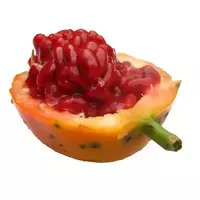Passiflora blue (cavalier star)

Passiflora blue (cavalier star) is one of the subspecies of the plant Strastotsvet or Passíflora, which is assigned by scientific classification to the family Strastflower. Currently, botanists have discovered and studied over 500 subspecies of the plant. The vast majority of passiflora species grow in the tropical climate of the American continent (Peru, Brazil).
Some species are found in Asia, as well as in Australia, Madagascar and the Mediterranean region. It is worth noting that edible species of passiflora are cultivated in the subtropical climatic zone of Transcaucasia. All types of passiflora have the same structure and appearance. Passiflora is nothing more than an annual herbaceous plant that is a climbing shrub.
The researchers claim that passiflora belongs to those rare species of the plant that until now evolve and change their characteristic features depending on the changes that occur in the environment. The fruits of three subspecies of the plant are eaten:
passiflora edible (Passiflora edulis) or passion fruit, a plant native to South America, and krmoe of that New Zealand, in the Hawaiian islands and in countries located in Southeast Asia;
Passiflora suberosa;
Passiflora blue (cavalier star) or Passíflora caerulea. It is noteworthy that the leaves of many subspecies of passiflora have unique healing properties that have long been used in folk medicine.
Researchers have found documentary evidence that in the 16th century, indigenous Americans used passiflora to treat liver diseases, as well as various ailments affecting human organs of vision. It is worth noting that the useful properties of such a plant species as Passiflora meat-red (Passiflora incarnata) are recognized as official medicine. Based on extracts obtained from the plant, medical preparations are made.
Edible passiflora blue (cavalier star) is native to Brazil, Uruguay, Paraguay, as well as Argentina. In addition, passiflora blue (cavalier star) is cultivated in the subtropical climate of the Black Sea coast of the Caucasus and Crimea. The fruits of passiflora blue (cavalier star) are oval-shaped and differ in their bright orange color. Inside the fruit there is red flesh, which is the red seeds of the plant.
Interestingly, the blue passiflora (cavalier star) on the territory of the Russian Federation is grown mainly as an ornamental, and not a fruit plant. This state of affairs is primarily associated with the climatic characteristics of the region. The rather harsh climate allows you to grow passiflora blue (cavalier star) at home or in specialized greenhouses. However, albeit extremely rare, passiflora is still used in our latitudes as an ornamental plant in gardens on open ground.
passiflora blue (cavalier star) 68 kCal
Energy value of passiflora blue (cavalier star) (Ratio of proteins, fats, carbohydrates - ju):
Proteins: 2.4 g (~ 10 kCal)
Fats: 0.4 g (~ 4 kCal)
Carbohydrates: 13.4 g (~ 54 kCal)
Energy ratio (b | y): 14% | 5% | 79%
 Español
Español Français
Français Português
Português Русский
Русский 简体中文
简体中文 繁體中文
繁體中文 日本語
日本語 한국어
한국어 العربية
العربية Türkçe
Türkçe Қазақ
Қазақ Deutsch
Deutsch Italiano
Italiano Українська
Українська
